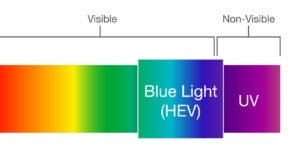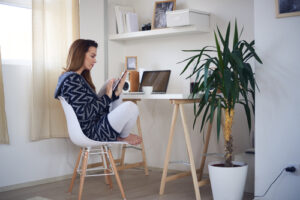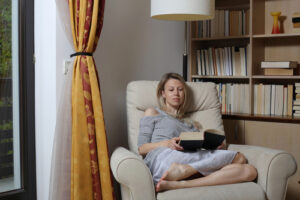As we continue adjusting to our new normal during a global pandemic, many people are working from home. This involves Zoom meetings, video calls with clients and co-workers, and even late-night chat sessions with friends.
But with so much extra time being spent on digital devices, what is all the blue light being emitted really doing to your eyes? Keep reading to find out and learn some tips to keep your eyes healthy!
What is blue light?

Blue light sounds like it should be exactly that: light that’s blue. But there’s more to it, of course.
Blue light is one of the light rays that we can see. Sunlight has red, orange, yellow, green, blue, indigo, and violet light.
When you combine these colors, it becomes white light, which is what we see. Each ray of light has wavelengths and energy that make up the light source.
Blue light has shorter wavelengths and more energy. The light that we perceive as white may have a large blue component to it.
Because of this, our eyes are then exposed to more wavelengths on the blue end of the spectrum of light.
Where am I being exposed to blue light?
The largest source of blue light that you’re being exposed to is the sun. But blue light is also emitted from many other sources as well. The second-largest source of blue light exposure may be from digital devices.

This includes things like your iPhone, your desktop computer for work, your iPad, your Kindle for reading, your television, and more devices. It’s not like you can stop using these devices and switch to paper, but too much blue light isn’t exactly good for you.
So what can you do?
Blue light is both good and bad for you
Like eating too much ice cream and getting a stomachache after, too much blue light is bad for you. In moderation, blue light is actually good for you!
- It can elevate your mood
- Increase your memory function
- Make you more alert
- Help you maintain a natural circadian rhythm which you need to develop a healthy sleep cycle
Another thing that people may not realize about blue light and digital devices is that it can cause eye strain. If you’ve noticed that your eyes feel more fatigued or tired than normal, these are some common signs of eye strain or computer vision syndrome.
Again, too much of a good thing becomes a bad thing. The key with blue light is to take breaks from your screens regularly. If you know you will be working on your computer for several hours, carve out time during the day for breaks.

Get up, walk around, and leave your screen! Don’t pick up your cell phone to scroll through Instagram or Facebook, either.
If you can, take a short walk outside. This will help your brain reset and give your eyes a few minutes to readjust. At the very least, you can practice the 20-20-20 rule.
With the 20-20-20 rule, take a break every 20 minutes. On this break, focus on an object that’s 20 feet away for 20 seconds.
This helps ensure that your eye muscles don’t get too tired as you’re working during the day. Even if you are working from home, remember that breaks are still important!
They may be even more important as you try to adjust to a new way of completing tasks.
Things you can try to reduce your blue light exposure
While working from home, it may seem impossible to reduce your blue light exposure. After you’re done working for the day, what you do with your time is up to you. Try some of these helpful tips to reduce your blue light exposure!
Treat your eyes and body with respect

It may be tempting, but staying up looking at your phone every night isn’t doing you any favors during a pandemic. If you’re finding it hard to fall asleep at night, try reducing the hours you spend looking at your phone before bed.
To get the most out of this, you need to stop looking at your phone about 2-3 hours before bed. Besides this, you can also try setting up “night mode” on your phone and then control when it automatically turns on.
iPhones have this mode already so all you have to do is turn it on! This will warm up the lighting on your device and reduce how much blue light you’re seeing at night.
If you need to read at night, don’t use an e-reader

You may love the convenience of your Kindle but it’s not helping you fall asleep any faster. Reading in bed with your e-reader is only going to knock your circadian rhythm out of its natural cycle, so if you must read, pick up a physical book.
Many experts recommend reading somewhere that isn’t the bedroom, like your living room, and then going to the bedroom to sleep once you feel tired.
Cut back on eye strain and invest in computer glasses instead

If your eyes still feel tired, you may want to consider trying out computer glasses. To get the best results, talk to your eye doctor, and schedule an appointment with them to discuss your options.
Takle Eye Group offers plenty of choices for glasses at our optical centers in both Griffin and Locust Grove, as well! Computer glasses are a great option because they can block out blue light that digital devices may emit throughout your workday.
If you do find that your eyes are suffering from computer vision syndrome or eye strain, you may also want to keep artificial tears on hand. With eye fatigue, another common symptom that goes along with it is having dry eyes.
When your eyes start to feel dry, having artificial tears on hand will help lubricate and soothe them instantly.
Concerned that working from home may be taking its toll on your eyes? Takle Eye Group is here to help! Schedule an appointment with one of our expert ophthalmologists in Griffin, GA now!




